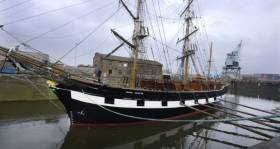Displaying items by tag: Final vessel
Jeanie Johnston Departs Dublin Port Graving Dock for Final Time
#PortHistory - Jeanie Johnston made history when at Dublin Port yesterday the tall ship floated out of its graving dock.
As the Irish Times writes the replica 19th century “Famine” ship is the last vessel to be worked on in the port’s graving dock as previously reported by Afloat. The dry-dock is being closed and filled in as part of the €230 million Alexandra Basin project.
The five-year project aims to allow larger ships to routinely call at Dublin, turn within Alexandra Basin and berth as far upriver as East Link Bridge.
Micheál Ó Cionna, who manages the Jeanie Johnston as a tourist attraction and museum, said the ship would return to its berth with Dublin Port tug assistance and would re-open later this week.
Mr Ó Cionna said the closure of the port graving dock emphasised the need for Minister for Heritage Heather Humphreys to save the last docks of this type in the Liffey area – on the Grand Canal Basin. For on this story click here.
























































